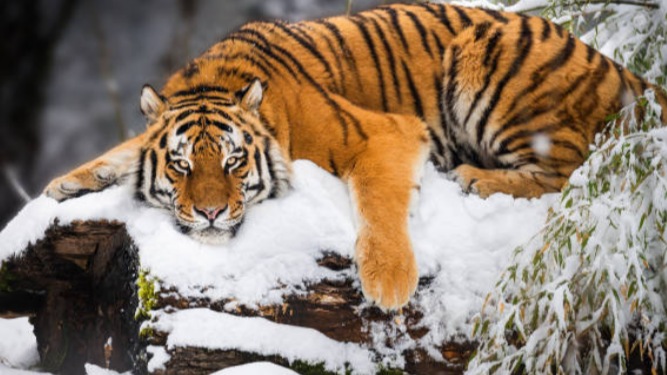
Tigers are carnivores and rely entirely on meat. They are solitary hunters, stalking their prey before pouncing. They require large territories to support their dietary needs, often consuming 15-20 pounds of meat in one meal. They may scavenge if necessary and can adapt to hunting smaller prey during food shortages.
There are six species of tigers in the world, Here are some food habits facts of them –

- Bengal Tiger 🐯🐯🐯
Bengal Tigers are found in India, Nepal, Bhutan, and Bangladesh, It is the most numerous tiger subspecies, with around 2,500 individuals in the wild. They are known for its vibrant orange coat with black stripes. There diet includes deers, wild boar, small animals, they are apex predators and ambush hunters.

2. Indo-chinese Tiger 🐯🐯🐯
Indo-chinese Tiger are found in Southeast Asia Cambodia, Vietnam, Laos, and Thailand. They are smaller and darker than the Bengal tiger. There population is critically endangered due to poaching and habitat loss. There diet includes wild pigs, deer, small mammals. They often hunts in dense forests.

- Malayan Tiger 🐯🐯🐯
Malayan Tiger are found in Peninsular Malaysia. They are smallest tiger subspecies. There population is fewer than 200 individuals. They eats sambar deer, wild boar, and monkeys mostly prefers to hunt at night.

- Sumatran Tiger 🐯🐯🐯
Sumantran Tiger are found in Sumatra, Indonesia. They are smallest tiger subspecies critically endangered, with fewer than 400 individuals in the wild. There diet includes tapirs, deer, and small mammals known to prey on birds and fishes.

- Siberian Tiger🐯🐯🐯
Siberian Tiger are found in Russian Far East, northeastern China, and parts of North Korea. They are largest tiger subspecies, with thick fur for cold climates. There population is around 500 in the wild. They preys on large ungulates like elk, deer, and wild boar. They can survive on smaller animals like hares if larger prey is scarce.

- South China Tiger🐯🐯🐯
South China Tiger are found in southern China now likely extinct in the wild. They are one of the most critically endangered subspecies, with only a few in captivity. They fed on deer, wild boar, and small mammals.
🐯Conservation efforts are crucial to ensure the survival of these majestic creatures, as they face threats from habitat destruction, poaching, and human-wildlife conflict.
